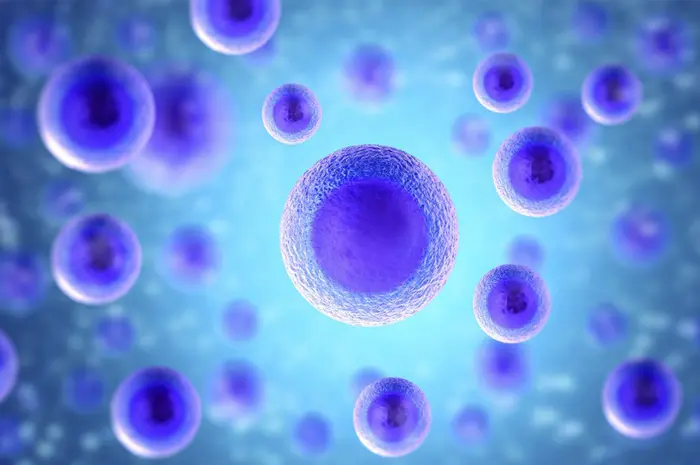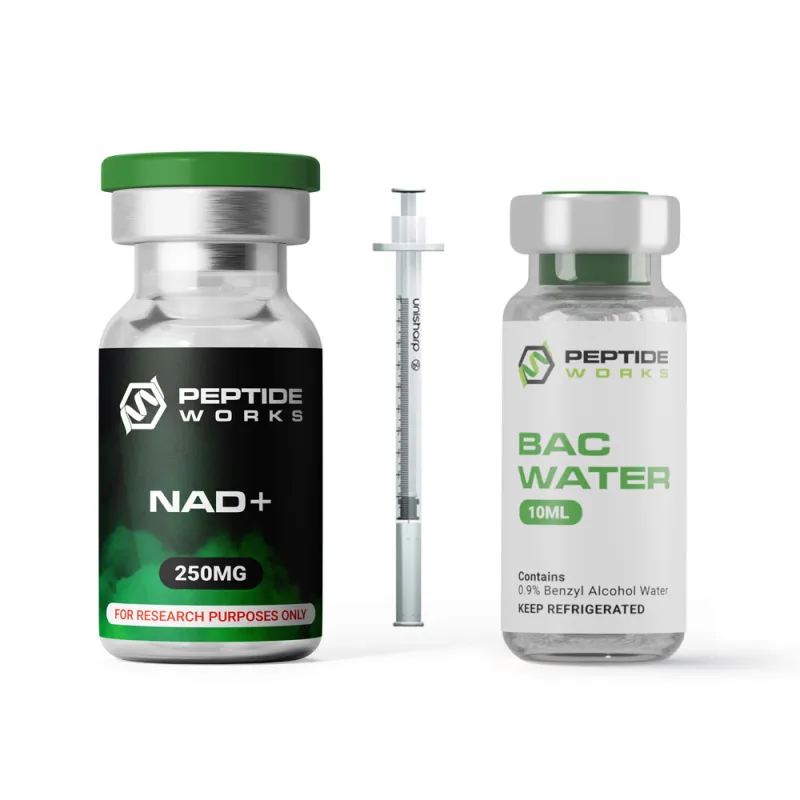
PROMO!
First order? Get 10% OFF with this code: 1storder
Written by

Humanin peptide shows powerful effects against cellular aging in research. This mitochondrial-derived peptide protects neurons from oxidative stress and inflammation.
Research reveals that humanin peptide levels naturally decline with age, and lower levels correlate with increased risk of Alzheimer’s and cardiovascular problems.
MOTS-c and NAD+ peptides work alongside humanin to maintain cellular energy, regulating metabolism and protecting mitochondrial function during aging.
Peptide Works provides these research peptides to facilities studying age-related diseases worldwide.
Explore Humanin Peptide from Peptide Works, a mitochondrial-derived peptide that protects aging cells by reducing oxidative stress and supporting neuronal and cardiovascular health.

Humanin peptide neutralizes harmful free radicals that damage aging cells. Research shows it activates antioxidant pathways inside mitochondria directly, increasing production of protective enzymes like SOD2 and catalase.
These enzymes break down reactive oxygen molecules before cellular damage occurs. Humanin peptide also prevents inflammatory signals from triggering cell death programs.
Studies indicate MOTS-c works with humanin to boost these antioxidant defenses. Together, they maintain healthy cellular function despite age-related oxidative challenges.
Humanin peptide activates key antioxidant enzymes that fight aging cell damage. These include superoxide dismutase, catalase, and glutathione peroxidase, which neutralize harmful molecules.
Boosting these enzymes helps mitochondria and cells resist oxidative damage. Humanin peptide also triggers the Nrf2 pathway, which regulates antioxidant defenses.
Research shows it works with MOTS-c and NAD+ peptides to maintain cellular energy and mitochondrial health.
| Antioxidant Enzyme | Function | Role in Aging Cells |
|---|---|---|
| Superoxide Dismutase (SOD2) | Converts superoxide radicals into less harmful molecules | Reduces oxidative stress in mitochondria |
| Catalase | Breaks down hydrogen peroxide into water and oxygen | Prevents cellular damage from reactive oxygen species |
| Glutathione Peroxidase | Neutralizes peroxides | Supports detoxification and protects cellular structures |
The Nrf2 pathway multiplies protective effects when activated by humanin peptide. This transcription factor moves into cell nuclei and turns on defensive genes. These genes produce hundreds of protective proteins that combat cellular stress.
Research shows humanin peptide keeps Nrf2 active for extended periods. MOTS-c peptides support this process by maintaining cellular energy for gene expression.
The activated genes include those making glutathione, heme oxygenase, and other protectants, creating lasting protection beyond direct antioxidant effects.

Glutathione levels drop as cells age, leaving them open to damage from free radicals and toxins. Research shows that Humanin Peptide raises glutathione by switching on genes that make this master antioxidant.
The peptide works through Nrf2 signaling to boost glutamate-cysteine ligase, the key enzyme for glutathione production. Higher glutathione levels help aging cells repair DNA damage, clear waste proteins, and fight inflammation more effectively.
This boost in cellular defense explains why Humanin shows promise in lab studies of heart disease, brain aging, and diabetes. The glutathione increase also helps mitochondria work better, giving cells more energy to handle daily stress and repair work.
Research highlights three major conditions where humanin peptide demonstrates protective effects. Alzheimer’s studies show it reduces amyloid beta toxicity and preserves memory function.
Cardiovascular research reveals humanin protects heart cells during oxygen deprivation events. Type 2 diabetes models demonstrate improved insulin sensitivity and glucose metabolism.
MOTS-c enhances these metabolic benefits through mitochondrial energy regulation. Recent data suggests humanin levels predict disease progression in aging populations. Peptide Works provides researchers studying these conditions with quality humanin peptide.

Alzheimer’s disease damages brain cells through toxic amyloid plaques and inflammation. Humanin peptide binds directly to amyloid beta, preventing these plaques from killing neurons.
The peptide also stops tau proteins from forming deadly tangles inside cells. Research data shows humanin calms brain inflammation by controlling microglial activation.
MOTS-c and NAD+ support this protection by maintaining neuronal energy production. Memory tests in research models show better results with humanin treatment. Brain scans reveal less shrinkage in areas protected by this peptide.
Discover NAD+ Peptide from Peptide Works, a vital coenzyme peptide that promotes energy production, DNA repair, and overall mitochondrial health during cellular aging.

Research shows this peptide aids memory by protecting brain cells against stress and toxic proteins. It blocks amyloid beta toxicity, helping neurons and synapses work better during aging.
Animal studies show improved learning and memory with peptide treatment in aging models. It keeps mitochondria healthy, providing energy for brain cells to function properly.
MOTS-C peptide boosts metabolic function and energy to support these memory effects. Together, these peptides may slow cognitive decline in aging populations, offering hope for brain health.
Discover MOTS-c Peptide from Peptide Works, a powerful mitochondrial peptide that boosts cellular energy, enhances metabolism, and supports healthy aging and mitochondrial function.
Research into Humanin Peptide continues advancing across multiple age-related disease models. Laboratory studies explore its therapeutic potential for Alzheimer’s disease, cardiovascular conditions, and metabolic disorders.
Scientists investigate biomarker applications where Humanin levels may predict disease progression patterns. Advanced research protocols focus on understanding cellular mechanisms and protective pathways activated by this mitochondrial peptide.
Future studies aim to develop targeted interventions for disease prevention strategies. Peptide Works provides standardized research peptides to laboratories worldwide, supporting scientific advancement in age-related disease research and the development of innovative peptide-based therapeutic approaches.
All peptides and compounds mentioned are strictly for research purposes only and not for human use.
[1] Gong Z, Tas E, Muzumdar R. Humanin and age-related diseases: a new link? Front Endocrinol (Lausanne). 2014 Dec 4;5:210.
[2] Coradduzza D, Congiargiu A, Chen Z, Cruciani S, Zinellu A, Carru C, Medici S. Humanin and Its Pathophysiological Roles in Aging: A Systematic Review. Biology (Basel). 2023 Apr 6;12(4):558.
[3] Zheng Y, Wei Z, Wang T. MOTS-c: A promising mitochondrial-derived peptide for therapeutic exploitation. Front Endocrinol (Lausanne). 2023 Jan 25;14:1120533.
[4] Kim SJ, Miller B, Kumagai H, Silverstein AR, Flores M, Yen K. Mitochondrial-derived peptides in aging and age-related diseases. Geroscience. 2021 Jun;43(3):1113-1121.
ALL CONTENT AND PRODUCT INFORMATION AVAILABLE ON THIS WEBSITE IS FOR EDUCATIONAL PURPOSES ONLY.
DISCLAIMER: These products are intended solely as a research chemical only. This classification allows for their use only for research development and laboratory studies. The information available on our Peptide Works website: https://peptide-works.com/ is provided for educational purposes only. These products are not for human or animal use or consumption in any manner. Handling of these products should be limited to suitably qualified professionals. They are not to be classified as a drug, food, cosmetic, or medicinal product and must not be mislabelled or used as such.
Peptide Works
Related Articles

Best Peptides for Women in Perimenopause: From Libido to Energy
Do you feel drained, struggle with focus, or notice your drive slipping during perimenopause? These changes are some of the

PT-141 for Women in Perimenopause: A Breakthrough for Low Libido
Perimenopause can bring more than just physical changes it often affects how women feel about intimacy, confidence, and connection. Many

Can Vitamin B12 Immune System Support Enhance the Effects of Thymosin Alpha-1?
The Vitamin B12 immune system link is important because this vitamin plays a crucial role in DNA synthesis, methylation, energy